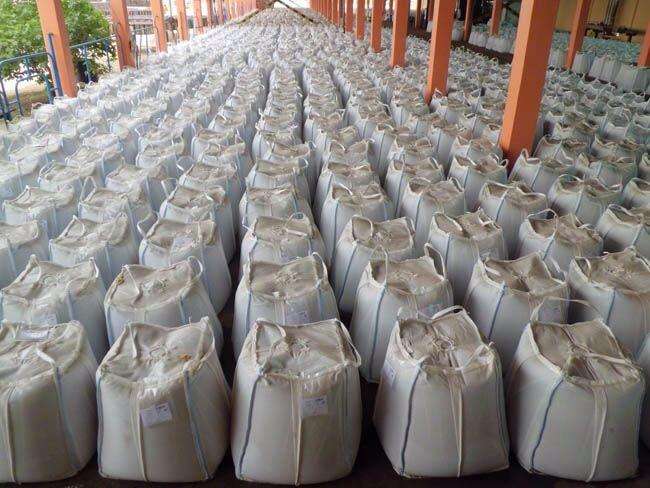Stearic acid

What is Stearic acid?
Stearic acid is a waxy solid product from refinery and its chemical formula is C17H35CO2H. Stearic acid name comes from the Greek word st?a? \”stéar\”, which means tallow ,Salts and esters of it are called stearates.
Stearic acid is one of the most common saturated fatty acids found in nature following palmitic acid, Triglyceride derived from three molecules of stearic acid is called stearin .Stearic acid is a saturated fat full acid with an 18-carbon chain
Therefore It is derived from fats and oils by the saponification of the triglycerides which is using hot water (about 100 °C). The resulting mixture will be then distilled. Commercial stearic acid is often a mixture of stearic and palmitic acid ,although the purified of it is also available.
Fats and oils rich in stearic acid are more abundant in animal type fat (up to 30%) than in vegetable fat (typically <5%). The important exceptions of it are the foods cocoa butter .
In terms of its biosynthesis, it is also produced from carbohydrates via the fatty acid .
Application of product
In general, the applications of stearic acid exploit its functional character, with a polar head group and a nonpolar chain that confers solubility in organic solvents. The combination leads to uses as a surfactant and softening agent.
Its undergoes the typical reactions of saturated carboxylic acids, and esterification with a range of alcohols. This is used in a large range of manufactures, from simple to complex electronic devices.
In Human diet
The fatty acids are absorbed in the regular diet the same as the free fatty acids. Low acute toxicity is shown. There was in 2017 no evidence at doses up to 10% in the diet for toxic effects.
Stearic acid Used in Soaps, cosmetics, detergents
Slack wax with 12% oil content is utilized in the production of wax emulsions, polishing boards, cable filling, paraffin wax, and PVC industries. It also acts as binders and waterproofing agents in artificial woods.”
Stearic acid finds extensive application in various industries, including the production of detergents, soaps, and ccosmeticss like shampoo and shaving cream products. While soaps are not directly manufactured from stearic acid, it plays a crucial role through the saponification process of triglycerides containing stearic acid esters.”
Esters of it with ethylen glycol, glycol stearate are used to produce a pearly effect in shampoos, soaps, and other cosmetic products. They are added to the product in molten form and allowed to crystallize under controlled conditions. Detergents are obtained from amides.
Lubricants, softening and release agents
In view of the soft texture of the sodium salt, which is the main component of soap, other salts are also useful for their lubricating properties. Lithium stearate is an important component of grease. The stearate salts of zinc, calcium, cadmium, and lead are used to soften PVC.
Its used along with castor oil for preparing softeners in textile sizing. They are heated and mixed with caustic potash or caustic soda. Related salts are also commonly used as release agents e.g. In the production of automobile tires Being inexpensive and chemically benign,
Applicated to make castings
As an example, it can be used to make castings from a plaster piece mold or waste mold. In this use, powdered stearic acid is mixed in water and the suspension is brushed onto the surface to be parted after casting.
This reacts with the calcium in the plaster to form a thin layer of calcium starate , which functions as a release agent ,when reacted with zinc it forms zinc stearate which is used as a lubricant for playing cards fanning powder to ensure a smooth motion when fanning .
Used as a negative plate additive
Mainly stearic acid used as a negative plate additive in the manufacture of lead-acid batteries. It is added at the rate of 0.6 g per kg of the oxide while preparing the paste. It is believed to enhance the hydrophobicity of the negative plate, particularly during dry-charging process.
It also reduces the extension of oxidation of the freshly formed lead (negative active material) when the plates are kept for drying in the open atmosphere after the process of tank formation.
Fatty acids are classic components of candle-making. Stearic is used along with simple sugar or corn cyrup as a hardener in candies.
In fire works stearic acid is often used to coat metal powders such as aluminium and iron .
This prevents oxidation, allowing compositions to be stored for a longer period of time.
Analysis of Stearic Acid
| CHARACTERISTIC | RESULT | METHOD |
| Iodine Value | Max. 1.5 | ISIRI 4886 |
| Melting Point | 58-62 C | ISIRI 4887 |
| Acid Value | 195-207 | ISIR 4178 |
| Stearic Acid | 70-75 wt% | ISIR 4090-4091 |
| Palmitic Acid | 25-30 wt% | ISIR 4090-4091 |
| Appearance | Flake | —- |
